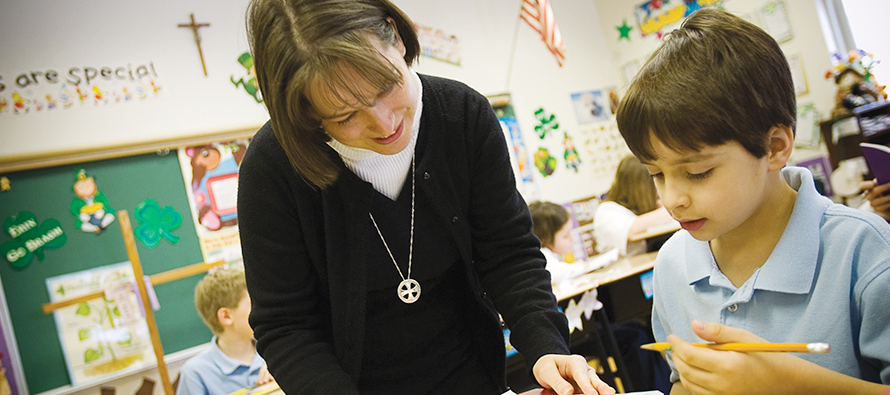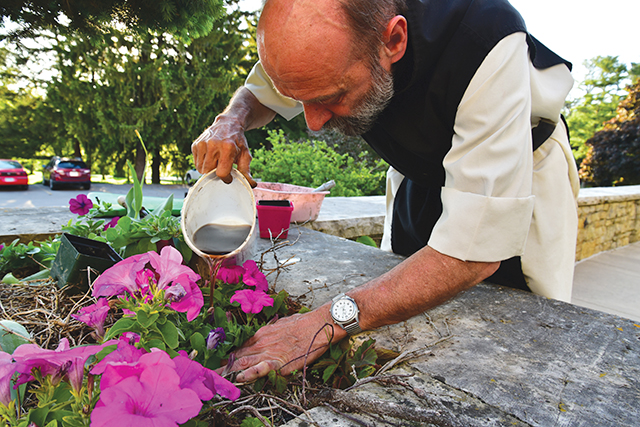Charism: The gift that shapes lives

Sister Lindena Brace, S.C., who belongs to the Sisters of Charity of Seton Hill, is fulfilling a charism that includes an emphasis on education. (Photo courtesy of the Sisters of Charity of Seton Hill)
A CHARISM is a gift that comes from the Holy Spirit. Its purpose? To serve others, and especially to build up and renew the Body of Christ, the church.
When religious communities use the word charism, they mean the particular gift of the Spirit that inspired their founder—a man or woman of bold vision, who gathered other people to help turn that vision into action.
The story of a community’s founder will reveal a charism in action. Often these people did not even envision founding a religious community; they simply felt a passion to do something to meet a specific need of their time. This burning desire came from the Spirit. Others wanted to join them, and out of this grew the community.
Charisms enable you to tell religious communities apart from one another. The Holy Spirit calls these groups of men and women to different things and gives them different gifts, such as preaching, teaching, praying, caring for the sick, and more. We need all these many gifts to build up the Body of Christ. The charism guides the community as it makes decisions about its mission and its future—whether the founder lived 50 or 500 years ago.
You have a charism, too. Sister Mary Pellegrino, C.S.J. writes in America, “[O]ur charisms are not confined to vowed, religious life. They are found and flourish among single and married persons, and clergy, as well.” Saint Paul says that each of us, by virtue of our Baptism, receives gifts of the Spirit for the good of us all.
Charisms begin as a reaction to needs
You can trace the development of a religious community’s charism back to a specific historical moment. That’s because the founder read the signs of the times, and, with a push from the Holy Spirit, moved into action to do what needed to be done. The Alexian Brothers, for example, trace their origins to 12th-century Europe when small groups banded together to tend the sick and bury the dead—revolutionary actions at the time. During the Black Death in the 14th century, which killed almost a third of Europe’s population, they stayed with the sick and dying when others fled. These lay brothers were not even recognized as a religious community by the pope until 1472.
Or consider the Sisters of Mercy. In 1827, Dublin’s Catherine McAuley used a sizable inheritance to open a house that would serve as a school for poor girls and a shelter for homeless girls and women. As other women volunteered to help, McAuley envisioned a lay corps of Catholic social workers, not a religious order—especially since sisters at the time were confined to their convents. Eventually the women realized that for the sake of stability they’d be better off as a religious community, though not stuck in a convent. They called themselves the Sisters of Mercy, as they sought to make tangible the merciful love of God to all, especially the poor. Dubliners, however, often called them the “walking nuns” because they spent so much time out in the community among the poor.
Evolving response
Religious communities continually reflect on their founding charism to figure out how best to put their heritage into action in today’s world. The Alexian Brothers in Chicago, for example, in the 1980s began taking people dying of AIDS into their personal residences, opening a permanent facility for them in 1989. Because family and friends often abandoned those suffering from AIDS, which bore a great moral stigma as well, the brothers stepped in to care for them, just as they had for the afflicted during Europe’s Black Death six centuries before.
The Mercedarians were founded in 1218 during the Crusades to ransom captive Christians. Today the community’s website declares: “Friars of the Order of Mercy continue to rescue others from modern types of captivity, such as social, political, and psychological forms. They work in jails, marginal neighborhoods, among addicts, and in hospitals.”
Saint Julie Billiart, the founder of the Sisters of Notre Dame de Namur, advised her sisters to “educate for life.” Her sisters still serve in Catholic schools, but for decades now have also been interpreting their charism more broadly. For example, Sister Thérèse DelGenio, SNDdeN, who works with homeless people, says she “educates for life” as a social worker helping people recover from substance abuse, trauma, domestic abuse, and chronic poverty, among other challenges.

What’s my charism?
If you’re considering joining a religious community, you’re likely asking yourself if you’re drawn to a particular charism and what gifts you have to live it. It can take time and a process of trial and error to figure it out.
Father Brian Walker, O.P. worked in missions before realizing what he really wanted to do was preach, so he joined the Dominicans, also called the Order of Preachers. “I wanted to preach in season and out, and now that’s what my whole life is about,” he says. “I preach from personal experience and from the scripture and how it’s spoken to me.” One of Walker’s favorite preaching themes is “To praise, to bless, to preach.”
“All of us are called to praise and recognize God in all creation, to bless one another and what has been given us, and also to preach about the goodness of all of that,” he says. “Not everybody can preach from the pulpit, but we all preach by what we say and do, how we treat one another, and how we interact with one another. What does our interaction leave in our wake? What does it say about us when we’re gone?”
Sister Sheryl Chen, O.C.S.O., a Cistercian nun, writes that the opportunity to sing the Liturgy of the Hours seven times a day was the main reason she joined the Cistercians. Her daily experience in the community, though, has changed over time: “When I was a novice, the silence was very strict. We had to learn a sign language to avoid speaking in the seven most important rooms in the monastery. Now we use common sense and charity to discern when it is simplest to have a quiet conversation. Our constitutions claim that only with a personal love for Jesus can one persevere in a life that is ‘ordinary, obscure, and laborious.’ If the mystery and intensity of that appeals to you, come and see!”
The charisms of religious institutes serve the church and society in hundreds of different forms. Consider your own gifts and attractions, then test the waters. It’s women and men of bold vision and commitment who live out the charisms of Catholic religious communities today. Perhaps you’re one of them.
A version of this article originally appeared in VISION 2018.
Related article: VocationNetwork.org, “A charism encourages a caring ministry.”
Tags
Related
- How my parents responded when I became a brother
- Vocation Basics: You are already called—Message to youth from Pope Francis
- Meet the parents
- What our vows mean
- Discover five treasures of religious life
- Religious making a difference
- Religious seekers in legal limbo
- Mercy meets at the border
- Religious life: The call continues
- Vocation Basics: Essentials for the vocation journey Read More
Most Viewed
- Find your spirituality type quiz
- Questions and answers about religious vocations
- Celibacy quiz: Could I be a nun? Could I be a brother? Could I be a priest?
- Resources for older discerners or those with physical and developmental differences
- About Vocation Network and VISION Guide


